Headphones for Language Documentation
 Photo Credit: Kevin Cline
Photo Credit: Kevin Cline
Looking at the overall audio recording picture in Language Documentation, the place of headphones is not to be taken lightly. The total recording act has a performer, performing the speech act, a microphone recording the sounds, a recording device digitizing the input from the microphone. And while it could all stop there, an additional step is needed – the monitoring of the input to the recording device. High quality sound is important in the recording process. If the Documenter does not have and ear for what a recording should be (training), then they are not going to be able to tell the difference between a good recording, a mediocre recording and a bad recording. It think it is well known, if not commonly acknowledged that a good mic is needed to make quality recordings (recordings which are faithful at recording the input). Likewise it is no less true that to listen to that recording to assure that it is truly a faithful recording a speaker or set of headphones is needed to produce a faithful output of the recording. So high quality audio (faithfulness to input and to the recording) is not only needed in the capture phase of the recording event but also in the monitoring phase (and the playback phase) of the recording event. Here inter the importance of headphones.
It is possible to record with out monitoring the recording but, actively monitoring recorded audio allows for on-the-spot quality control. I have seen some tears shed when a documenter waited till later to find out that the mic record level was set too low or that the record button was not pushed.
It is also possible to record with low quality headphones, or headphones which are not faithful to the recording. But when these kinds of speakers or headphones are used there is no way to accurately access the quality of the recording. I have seen a good quality recording played through laptop speakers and questioned as being a “quality” recording. I have also seen a poor quality recording listened to on poor quality speakers and thought it was a fine recording, only to find out later what the true quality of the recording really was.
Recording volume (or Mic sensitivity) + Speaker volume = Total listening experience.
Just raising the volume on a speaker or a pair of headphones might make the audio more hearable but does not mean that a good recording is being captured. Conversely, a low speaker volume and a high mic record level does not make a great recording either. (It might be the right setup for your recording session but it does not guarantee a good recording all the time.)
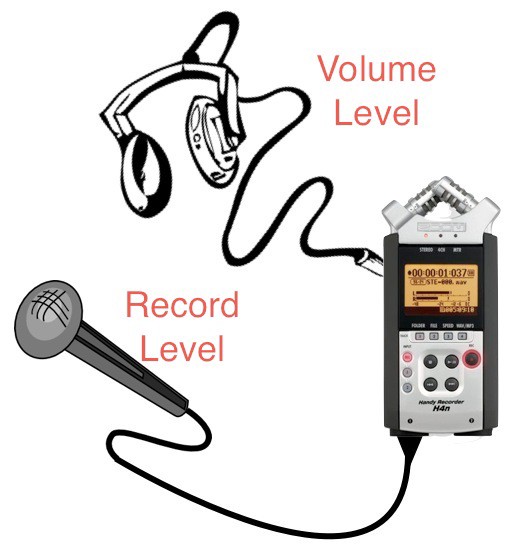
Record and Volume Levels. Credit: Hugh Paterson III
Just as Language Documentation is about Capturing the Event, (Citation: Nathan, 2010) Nathan, D. (2010). Sound and unsound practices in documentary linguistics: towards an epistemology for audio. In Austin, P. (Eds.), Language Documentation and Description. (pp. 262–284). The Hans Rausing Endangered Languages Project, School of Oriental and African Studies. Retrieved from http://www.elpublishing.org/content/Sound-and-unsound-practices-in-documentary-linguistics-towards-an-epistemology-for-audio headphones are about Monitoring the Recording.
Headphones v.s. Speakers
Headphones have the distinct advantage over Speakers for not re-introducing noise into a recording, especially in a field recording environment. However, both can be used to monitor a recording. When I recorded in a professional recording studio the mixing room was isolated from the performance rooms and we had Speakers in the mixing room.
Different Uses
Different kinds of Headphones serve different purposes. A good knowledge of your purpose and a good knowledge of the right kinds of headphones will lead to a great experience. First, lets take a look at the audio listening needs on a language documentation project.
- Documenter listening to the audio feed while video taping.
- Documenter listening to the audio while recording.
- Documenter and Consultant listening to audio while recording with the BOLD method. (Citation: Reiman, 2010) Reiman, D. (2010). Basic Oral Language Documentation. Language Documentation, 4. 254–268. Retrieved from http://hdl.handle.net/10125/4479
- Documenter editing audio and video.
- Documenter doing analysis and annotation in the field with tools like Audacity, Praat and ELAN.
- Documenter listening to their iPod in their hammock at night.
With these difference in mind, it is easy to see that various Language Documentation Projects will have different functional requirements depending on the project goals. Additionally, Language Documentation projects often have constraints on their weight of gear to area of service ratios. (Sometimes the documenter just can’t take everything. So take the right tool for the job and hope that tool is light weight.) Headphones come into the equation, as apposed to speakers, because they can deliver high quality sound at a low weight. However, should the language documenter just grab their iPod headphones and think that they will be alright?
What kinds of headphones are there?
There are several basic kinds of headphones which can be roughly broken down into 4 types of headphones (Depending on who is consulted.) Types of headphones on:

Various kinds of headphones as displayed by Apple Credit: Apple, Inc
- First, there are over-the-ear headphones or Circumaural headphones which cover the wearers ears completely.
These come in two varieties:
- Open Back - which lets ambient noise into the wearer's ear canal.
- Closed Back - which isolates the wearer from noise which is not in the recording.
- Second, there are on-the-ear headphones or Supra-aural headphones. Supra-aural headphones sit on the wearers ear rather than covering it completely.
- Lastly, there are in-the-ear headphones. This group can actually be divided into two sub-groups:
- Ear buds, such as the Apple iPod Earphones, which sit in the wearers outer ear, just above the opening of the ear canal.
- True in-the-ear headphones or In-ear monitors which are actually inserted into your ear canal and isolate the wearer from exterior noise.
How do I know a good set of headphones from a bad set?
Well there are several ways we can answer the question as to what is “good” set of head phones. The most succinct way to say it is likely to be:
Closed back circumaural, 20-20k.— Will Reiman
More generally, consider weight, size, durability, fit, frequency response and price.
Weight:
The Lower the weight the better: less strain on the neck after hours of use and the less weight to carry around with you.
Size:
Do they fold up? Are they compact and easy to pack and carry with your other gear?
Fit:
- Are they comfortable for people with large ears? You might not have large ears but if you are asking someone else to wear them then will it be comfortable for them, especially if you are asking them to wear them for a long period of time (long recording sessions).
- Can they be worn with an over the head mic?
- Can they be worn by someone wearing glasses?
- Are they adjustable? Adjustable for head circumference and pronation around the ear.
Quality of sound:
- Frequency response: Frequency response should minimally be 20Hz-20kHz. (because that is generally the range of human hearing.) I like going for 5Hz-30kHz because it gives me a full range of bass. I feel like I am hearing the whole range of sound.
- Flat response: Just like microphones, speakers (and headphones) can make some frequencies (warmer) try and get a set of head phones which are true to signal (flat response).1

Headphone Frequency Response graph by PCMag comparing three sets of headphones. Credit: PCMag
Price:
I think I paid $50 (USD) for the Sony MDR-V600 even though the suggested manufactures price is over $100. So look look around. Find a deal.
Review of my Field Tested Headphones
Here is a look a some of the Headphones I have and I have used. How I used them and what I thought about them.
Standard Apple Earbuds
My rating: 3.0 stars out of five.
Summary: These are the ones which come with my iPod.
Acquire them at: [Amazon] [Headphone Reviews]2
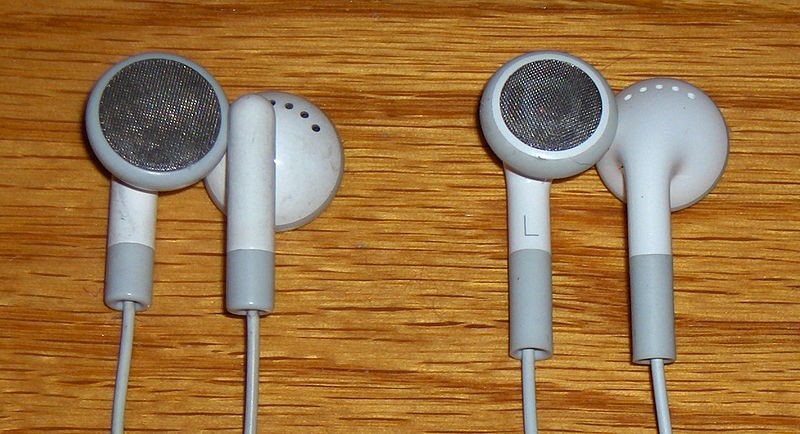
Apple Earbuds Credit: The Internet
Headphone Type: Canal
Fit Style: Earbud
Frequency response: 20Hz to 20,000Hz
Impedance: 32 ohms per Apple for newer models, 16 ohms for older 2008-ish models.
Plug Type: 1/8-inch
Cable Type: Straight
Cord Length: Approximately 0.5 meters
Weight: 0.15 pounds
Comments: These are the ones which come with your iPod. How I use them: I listen to my iPod with them. I also listen to music through my computer with them.
Olympus Earbuds
My rating: 4.5 stars out of five.
Summary: They came with my Olympus WS-320M Digital Voice Recorder. No type ID indicated and they are not the ones indicated on the website currently.
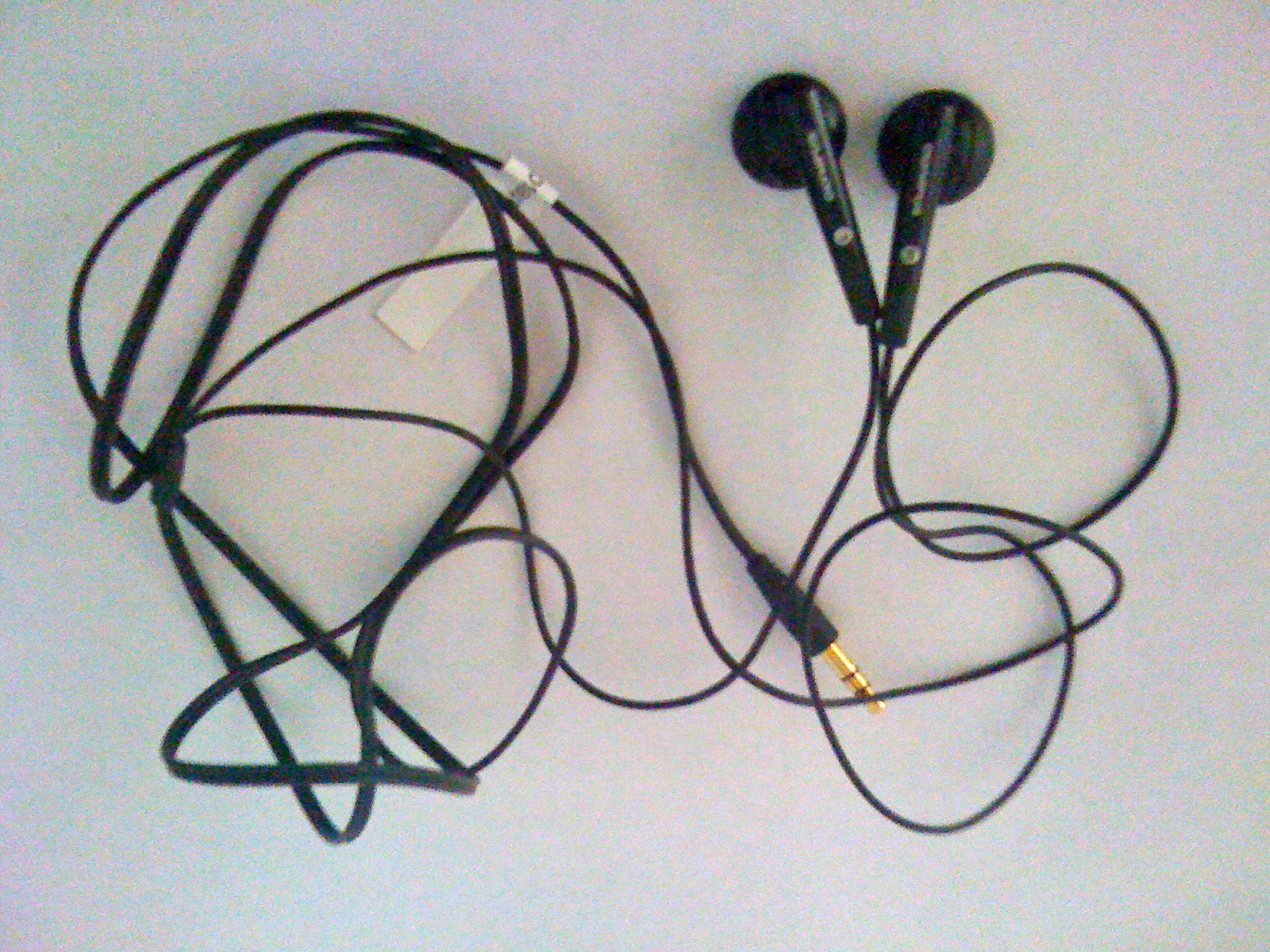
Olympus Earbuds Credit: Hugh
Headphone Type: Canal
Fit Style: Earbud
Frequency response: ?
Impedance: ?
Plug Type: 1/8-inch
Cable Type: Straight
Cord Length: Approximately 0.5 meters
Weight: 0.15 pounds
Comments: Really clear and crisp sound. It took some getting used to because they are different than the iPod earbuds.
How I use them: I use these to actively monitor the audio though the video camera (Vixia HF200).
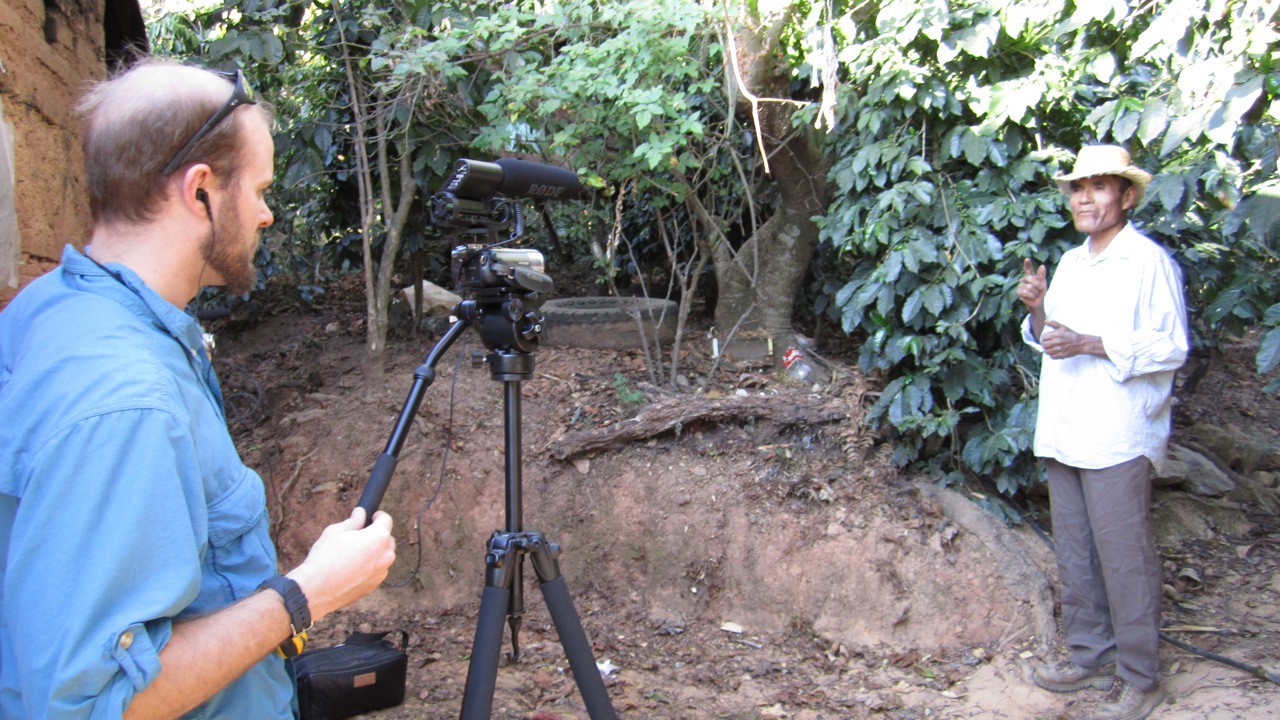
Actively monitoring the audio though the video camera. Credit: Kevin Cline
Samson CH700
My rating: 3.0 stars out of five.
Summary: This is the pair that came in my Zoom H4n Kit. [Samson] [Amazon] [Headphone Reviews]
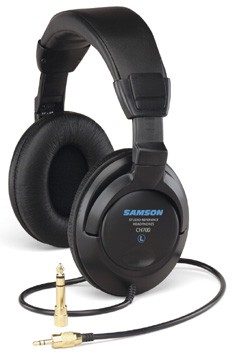
Samson CH700 Credit: The Internet
Headphone Type: Closed Back
Driver Size: 40mm
Fit Style: Circumaural
Frequency Response: 20Hz-22,000Hz
Impedance: 64 ohms
Plug Type: 1/8-inch to 1/4-inch adapter
Cable Type: Straight
Cord Length: Approximately 3 meters
Weight: 1.1 pounds
Comments: These came in a packaged kit with the Zoom H4n. They are a bit on the heavy side. they do have a nice sound to them. The do have an adjustment slider to fit various sizes of heads. They are not very compact.
How I use them: I use these to actively monitor recorded audio. Mostly when using a Zoom H4n, but also with an Olympus LS-10.
Sony MDR-V600
My rating: 5.0 stars out of five.
Summary: A High frequency response range and a good reputation for durability. The Sony MDR-V600 is not to be confused with the Sony MDR-V6 which only has a response rate of 10Hz - 20,000Hz. (Many search engines do confuse the two.) [Sony] [Amazon] [Headphone Reviews] [ProductWiki]
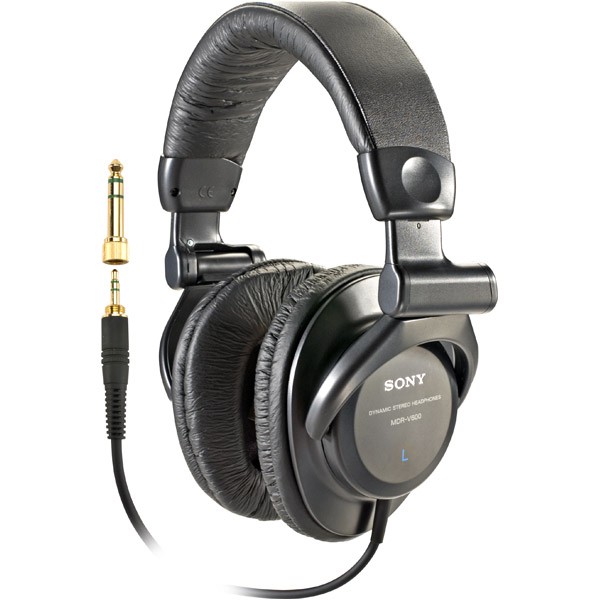
Sony MDR-V600 Credit: The Internet
Headphone Type: Closed Back
Fit Style: Circumaural
Frequency Response : 5Hz - 30,000Hz
Sensitivity : 106dB/mW
Impedance : 45 ohms
Plug Type: 1/8-inch to 1/4-inch adapter
Cable Type: curly
Cord Length: Approximately 2 meters
Driver Unit : 40mm
Weight: 0.5 pounds
Comments: Between these and the Samson CH700 I like these much better. They are lighter, and more compact. They have a larger frequency response than the CH700. And they are adjustable for various head shapes.
How I use them: I use these to actively monitor recorded audio. Mostly when using a Zoom H4n.
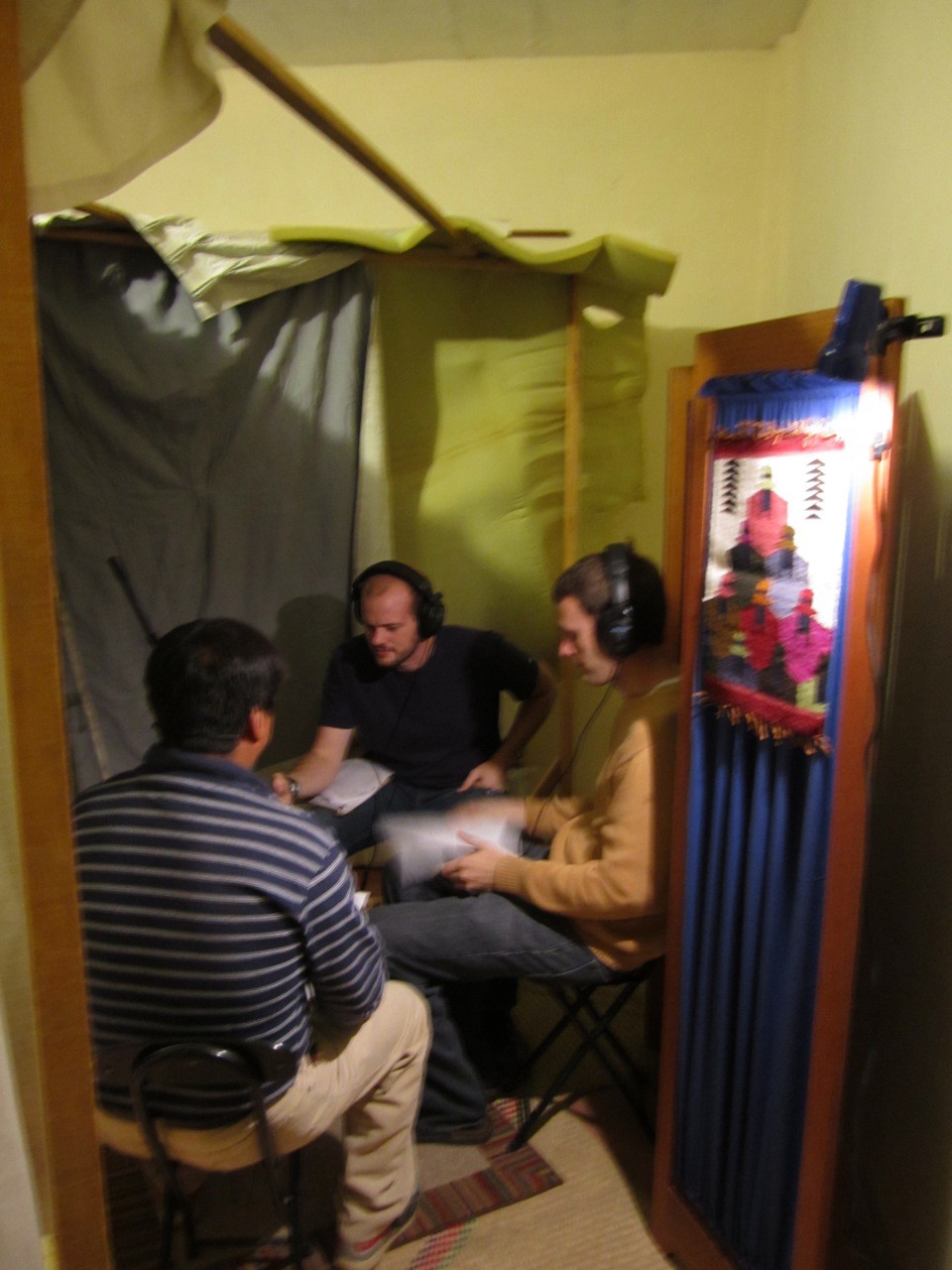
Wearing MDR-V600 headphones while recording an elicitation session. Credit: Stephen Marlett
Bibliography
- Nathan (2010)
- Nathan, D. (2010). Sound and unsound practices in documentary linguistics: towards an epistemology for audio. In Austin, P. (Eds.), Language Documentation and Description. (pp. 262–284). The Hans Rausing Endangered Languages Project, School of Oriental and African Studies. Retrieved from http://www.elpublishing.org/content/Sound-and-unsound-practices-in-documentary-linguistics-towards-an-epistemology-for-audio
- Reiman (2010)
- Reiman, D. (2010). Basic Oral Language Documentation. Language Documentation, 4. 254–268. Retrieved from http://hdl.handle.net/10125/4479
-
Read about how PC Magazine tests their headphones: How We Test Headphones. ↩︎
-
Taken from Apple’s website on April 5th, 2011. ↩︎
Categories: